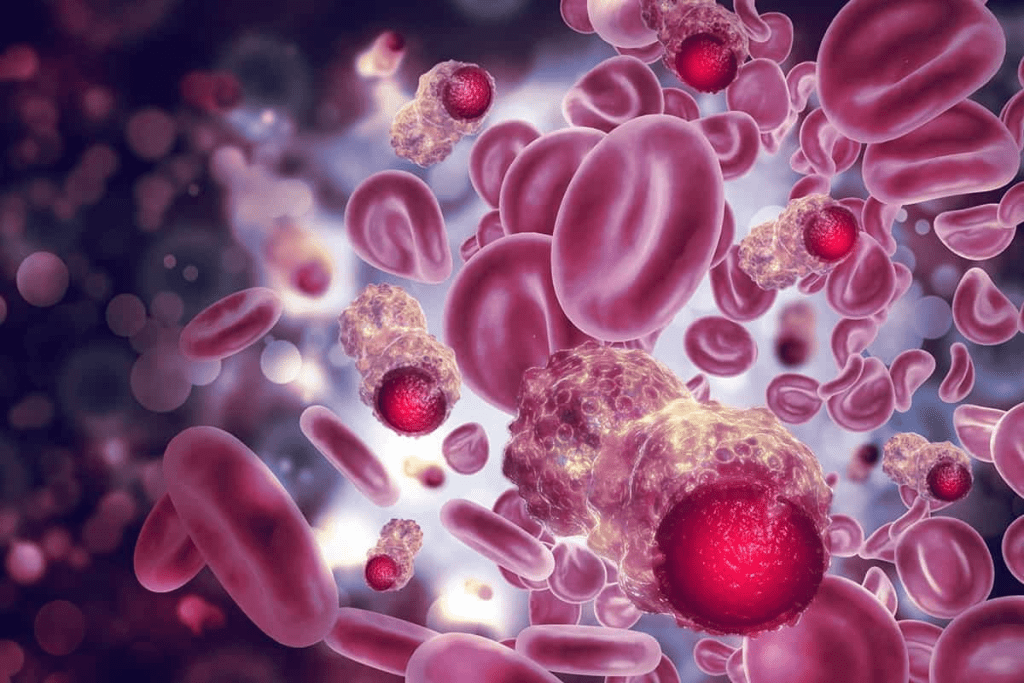Last Updated on November 13, 2025 by

Immune Thrombocytopenia (ITP) is a condition where you have too few platelets. This can cause easy bruising and bleeding. It’s not cancer, but people often mix it up with leukemia, a blood cancer. Knowing the difference is key to the right treatment. Can ITP be mistaken for leukemia? Read the wiki itp information on differential diagnosis. Learn this scary, yet crucial fact about initial misdiagnosis.
Distinguishing between ITP and leukemia needs a detailed diagnosis. This includes looking at symptoms, how common they are, and treatment choices. Even though ITP isn’t cancer, its symptoms can look like leukemia’s. So, getting the right diagnosis is very important.
ITP and leukemia are two different conditions. They have different definitions, symptoms, and ways to diagnose them. We will look into these to understand why they are often mixed up.
ITP is an autoimmune disease. It causes a low platelet count without affecting other blood cells. ITP happens when the immune system attacks and destroys platelets, which are important for blood to clot.
In kids with ITP, doctors often use corticosteroids and IVIG (Intravenous Immunoglobulin) to raise platelet counts. Sometimes, thrombopoietin receptor agonists are given to help make more platelets.

Leukemia is a cancer that affects the blood and bone marrow. It causes abnormal white blood cells to grow too much. This can lead to anemia, infections, and bleeding problems because normal bone marrow cells are pushed out.
ITP and leukemia can have similar symptoms, like bruising and bleeding. But they are different because leukemia has abnormal cells, and ITP has just low platelets. Getting the right diagnosis is key because treatments are very different.
For example, ITP might be treated with rituximab in kids. But leukemia needs stronger chemotherapy. Knowing the differences helps doctors give the right treatment.
Understanding these differences is important for doctors to make the right diagnosis and treatment plan. We will keep exploring these conditions in the next sections.
Understanding Immune Thrombocytopenia (ITP) is key to treating it well. Knowing how common ITP is helps doctors help patients more effectively. This knowledge shows how ITP affects different groups of people.
ITP can happen to anyone, at any age. Adults and children can both get it. In adults, it often lasts longer than in kids. Children usually have a better chance of getting better.
Kids with ITP might need immunosuppressants if it’s serious. Rituximab is a treatment that works well for kids who don’t get better with other treatments.
How common ITP is varies. It can be found in 0.9 to 2.6 per 10,000 people. This change comes from different people and how doctors diagnose it. Knowing how common it is helps healthcare systems plan better.
Sometimes, kids with ITP need platelet transfusions for severe bleeding. But this is usually only in emergencies because of the risks.
ITP affects many people, but some groups more than others. Young women are more likely to get it in adulthood. Knowing this helps doctors treat each patient better.
“The epidemiology of ITP highlights the need for a nuanced approach to diagnosis and treatment, considering the patient’s age, gender, and other demographic factors.”

Looking at the data helps doctors understand ITP better. They can then work on making treatments better for everyone.
It’s important to know how ITP and leukemia show symptoms. Both can have similar signs, making it hard to tell them apart.
People with ITP or leukemia might feel tired, weak, and have trouble breathing. This is because of low blood cells or platelets. Thrombocytopenia, or low platelets, is a key sign of ITP, but it can also happen in leukemia.
They might also have bleeding signs like small spots on the skin, bruises, or bleeding in the mouth. These signs make it even harder to figure out what’s wrong.
Bleeding signs are a big part of both ITP and leukemia. How often and how badly the bleeding is can differ a lot from person to person.
The way thrombocytopenia shows up can help doctors guess what’s wrong. In ITP, it’s usually just the platelets that are low. But in leukemia, other blood cells might be off too.
Knowing this helps doctors decide what tests to run and how to treat it. This includes first-line therapy in pediatric ITP.
Understanding ITP’s unique features is key to accurate diagnosis and treatment. ITP is a complex condition that needs careful consideration. Its distinctive traits help differentiate it from other blood disorders.
ITP is marked by isolated thrombocytopenia, where patients have low platelet counts. This isolated reduction in platelets is a key diagnostic criterion. “The presence of isolated thrombocytopenia simplifies the diagnosis of ITP,” as noted by medical professionals. Corticosteroids and IVIG are commonly used treatments, often in pediatric cases.
In ITP, white and red blood cell counts are typically normal. This distinguishes it from conditions like leukemia, where these counts are often abnormal. This normalcy in other blood cell counts is a critical diagnostic indicator. The management of chronic ITP in children involves careful monitoring and sometimes immunosuppressive therapy.
Another distinctive feature of ITP is the absence of organomegaly. This refers to the enlargement of organs such as the spleen or liver. Patients with ITP usually do not have significant organ enlargement or lymphadenopathy. The absence of these physical findings supports the diagnosis of ITP. As one medical source states, “The lack of organomegaly or lymphadenopathy in a patient with thrombocytopenia points towards ITP.”
In summary, ITP’s distinctive features include isolated thrombocytopenia, normal white and red blood cell counts, and the absence of organomegaly. Recognizing these characteristics is essential for diagnosing and managing ITP effectively, even in children, where chronic ITP management is a consideration.
Leukemia diagnosis relies on spotting specific signs. These signs help tell it apart from other diseases like Immune Thrombocytopenia (ITP). It’s a complex condition needing a detailed look to find its unique traits.
Leukemia is marked by odd blood cell counts. You might see anemia, thrombocytopenia, or leukocytosis. These signs point to bone marrow problems.
The bone marrow in leukemia can’t make normal blood cells. Instead, it fills up with immature or cancerous cells.
“The diagnosis of leukemia relies heavily on the identification of abnormal blood cell counts and the presence of specific cellular markers,” as noted by hematology experts.
Leukemia is also known for having immature or odd cells in the blood or bone marrow. Tests like the peripheral blood smear and bone marrow biopsy can find these cells. Finding blast cells is key, as they’re a leukemia sign.
A complete blood count (CBC) is key in diagnosing leukemia. It shows the number of different blood cells. If these numbers are off, it might mean leukemia.
A peripheral blood smear is a big part of diagnosing leukemia. It looks at blood under a microscope for odd cells. This test can spot blast cells or other immature cells typical of leukemia.
Together, CBC results and blood smear findings help doctors accurately diagnose leukemia. They can then plan the best treatment.
For patients with refractory Immune Thrombocytopenia (ITP), new treatments are key. We look at the latest methods, like rituximab for kids with ITP and using immunosuppressants.
Rituximab is a promising treatment for kids with hard-to-treat ITP. Research shows it helps increase platelet counts. It also cuts down on the need for other treatments and lowers bleeding risks.
When ITP is severe or doesn’t respond to treatment, doctors might use immunosuppressants. These drugs help stop the immune system from attacking platelets. For kids with ITP, emergency treatments like platelet transfusions are vital. They help manage severe bleeding.
Using immunosuppressants in kids with ITP needs careful thought and monitoring. This helps avoid side effects and get the best results.
ITP is an autoimmune disease that lowers platelet count. Leukemia is a blood and bone marrow cancer. Both can cause similar symptoms, but are treated differently.
Both can cause bruising, bleeding, and small spots on the skin. Leukemia may also lead to fatigue, weight loss, and bone pain.
ITP is diagnosed by low platelet count and normal blood cell counts. A CBC and blood smear help rule out other conditions.
Refractory ITP treatments include rituximab for kids, immunosuppressants, and platelet transfusions. Thrombopoietin receptor agonists help make more platelets.
Yes, corticosteroids and IVIG are first-line treatments for kids with ITP. They help increase platelet count and reduce bleeding risk.
Leukemia is diagnosed by abnormal blood cell counts and immature cells. Complete blood count and blood smear analysis are key.
Immunosuppressants treat refractory ITP by stopping the immune system from attacking platelets. They are often used with other treatments.
Yes, platelet transfusions are used in emergencies to quickly raise the platelet count and stop bleeding.
Tomita, E., et al. (1980). Differential diagnosis of various thrombocytopenias in childhood. The Japanese Journal of Hematology, 31(1), 177-186. https://www.nature.com/articles/pr198030
Subscribe to our e-newsletter to stay informed about the latest innovations in the world of health and exclusive offers!